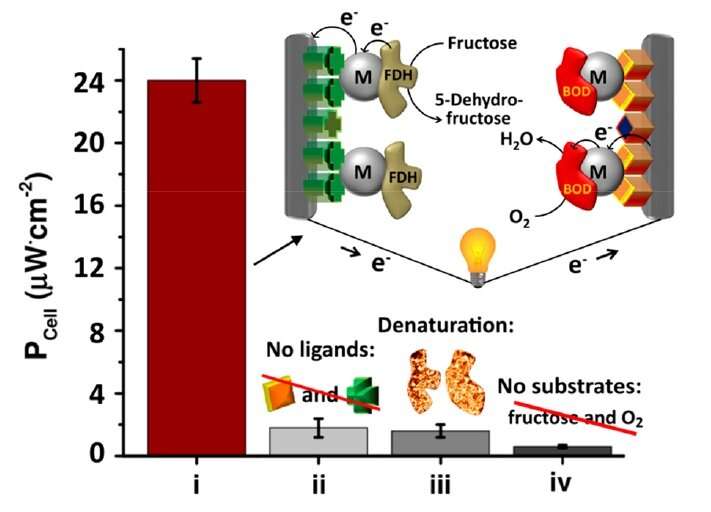August 5, 2019 feature
Power generation achieved by a self-assembled biofuel cell

Researchers have developed the first fully functional biofuel cell whose biocatalysts (enzymes that play a critical role in power generation) directly self-assemble onto the electrodes. In about 5 minutes, enzyme-nanoparticle hybrids added to a biofuel cell solution selectively bind to either the anode or the cathode, and in doing so form the key components of the biofuel cell.
The researchers, headed by Andreas Stemmer, along with Alexander Trifonov and Ran Tel-Vered, all at the Nanotechnology Group at ETH Zürich, have published a paper on the self-assembled biofuel cells in a recent issue of ACS Nano.
"We have demonstrated a self-assembled biofuel cell that provides on-demand power generation that can be switched on and off by a magnetic field," Trifonov told Phys.org. "The system also enables electrodes to be reused multiple times with only exchange of the active elements."
In recent years, self-assembly methods have been investigated as a tool for fabricating a variety of nanoscale structures, which have potential applications in fuel cells, batteries, and other energy storage and generation devices. In self-assembly, one of the most common strategies is to use force fields (electric, magnetic, etc.) to make certain regions more energetically favorable to nanoparticles, guiding them to aggregate in these regions. So far, however, a fully functional biofuel cell has not yet been formed using any kind of direct self-assembly method.
The biofuel cell reported here is designed to convert fructose-containing fluids, such as grape juice, into electrical power. To do this, the cell uses enzymes as an active element to release electrons from the sugar (through oxidation) into the anode. Then the electrons travel through a wire to the cathode, generating an electric current. At the cathode, other enzymes use the electrons (through reduction, the reverse of oxidation) and oxygen present in the solution to produce water.
One of the greatest challenges facing biofuel development is immobilizing the oxidation- and reduction-catalyzing enzymes close enough to the electrodes to ensure that the electrons released from the sugar end up in the oxygen-reduction process. Immobilization is necessary so that the oxidation and reduction processes occur simultaneously, enabling continuous current flow through the wire. If one of the biofuel cell's compartments (either cathode or anode) does not work properly, the whole process grinds to a halt.
This is where the self-assembly process becomes very helpful, as it forces both types of enzymes (oxidation-catalyzing and reduction-catalyzing) to closely bind to the appropriate electrode (anode or cathode, respectively). The enzymes are first hybridized with carbon-coated magnetic nanoparticles, which themselves are attached to one of two types of ligands, which are molecules with special chemical properties. When a mixture of these enzyme-nanoparticle hybrids is placed in the biofuel cell, reactions between the ligands and electrodes force the oxidation-catalyzing enzyme-nanoparticles to bind to the anode, while the reduction-catalyzing enzyme-nanoparticles bind to the cathode. This achieves the goal of immobilizing the enzymes at the appropriate electrode and allows for uninterrupted oxidation and reduction processes.
The researchers also demonstrated another potentially useful feature of the design: disassembly. As the nanoparticles are magnetic, an applied magnetic field causes the enzyme-nanoparticles to detach from the electrodes, terminating the current and releasing the nanoparticles into the electrolyte from which they can be removed. Then a fresh batch of enzyme-nanoparticles can be added, which, like before, self-assemble onto the electrodes. This ability to refresh older, degrading biocatalysts with new ones provides a way to reenergize the cell and prolong its lifetime.
The current version of the biofuel cell has a relatively low power output compared to non-self-assembled biofuel cells, but the researchers expect that the performance could be significantly improved with various optimization techniques, which they plan to investigate in the future. Other areas to explore include tailoring the enzyme-nanoparticles with different molecules for various functions, as well as modifying the cell to use different fuels.
"The future plan for this topic is to expand the presented technique for various types of enzymes, which will enable energy harvesting out of many different fuels (such as glucose, lactate, alcohols, etc.)," Trifonov said. "In addition, we aim to extend the lifetime of such biofuel cells, along with testing of different combinations of interactions for the self-assembly process to enlarge the surface area covered by enzyme-magnetic-nanoparticle hybrids (the main problem of the demonstrated technology) to enhance the final power output of the device."
More information: Alexander Trifonov, Andreas Stemmer, and Ran Tel-Vered. "Power Generation by Selective Self-Assembly of Biocatalysts." ACS Nano. DOI: 10.1021/acsnano.9b03013
Journal information: ACS Nano
© 2019 Science X Network



















